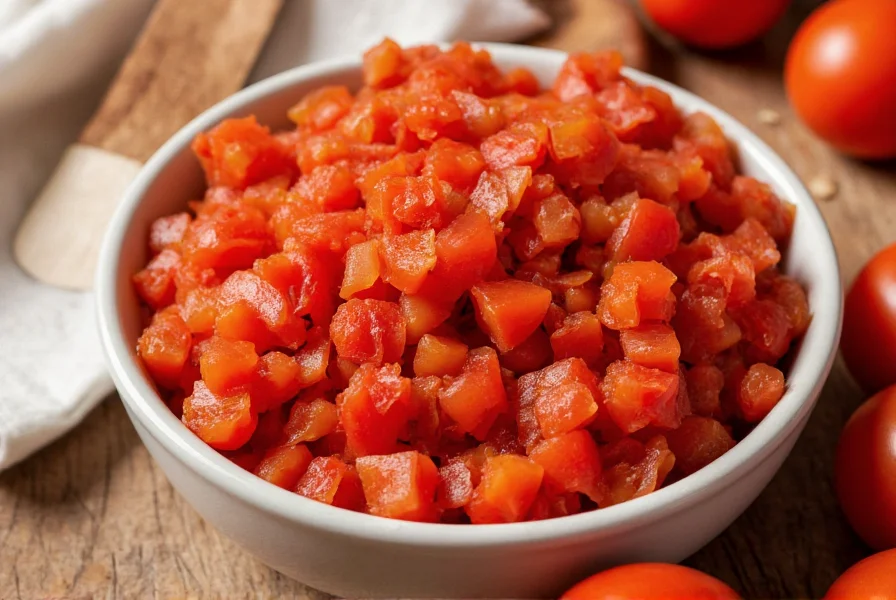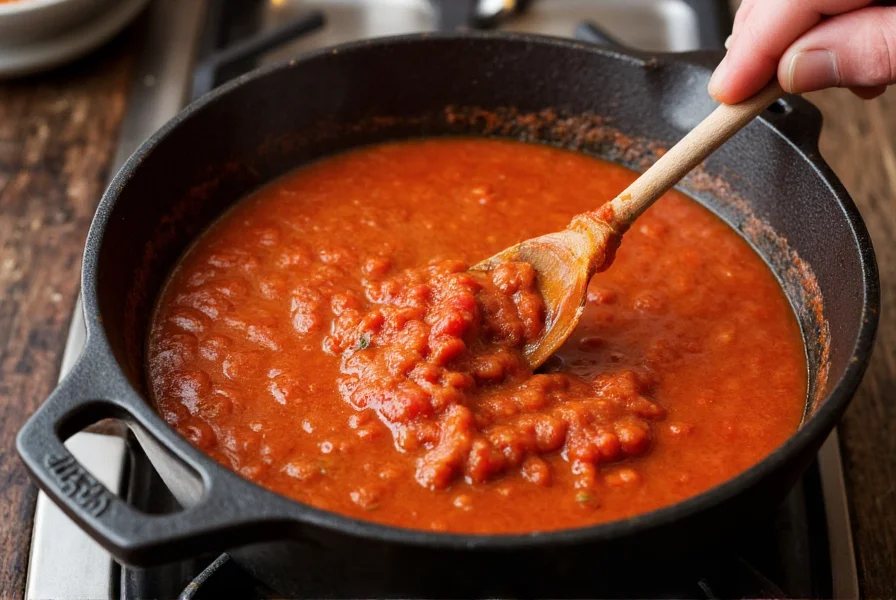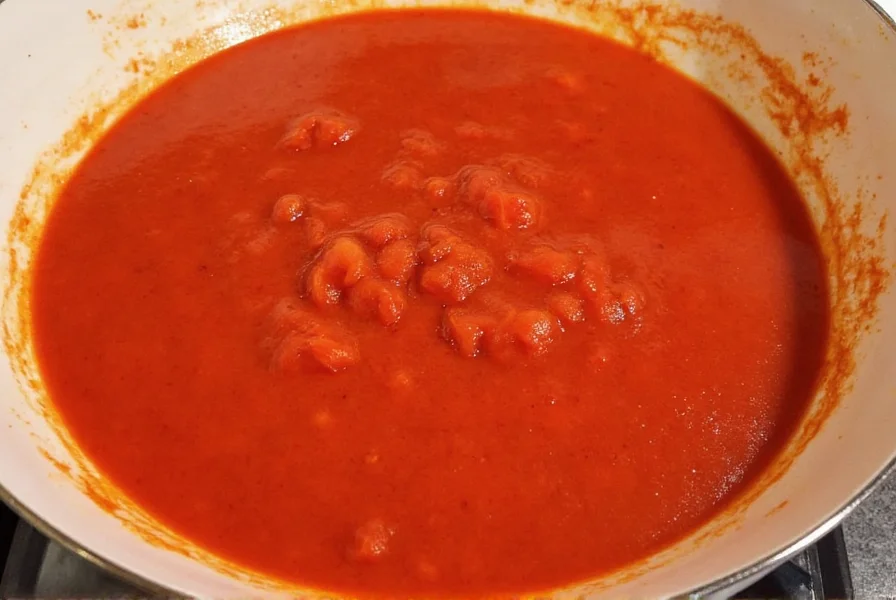When making chili, selecting the right tomato product significantly impacts your final dish's texture, flavor depth, and overall success. Many home cooks mistakenly reach for regular tomato sauce when crafting chili, only to end up with a watery, underwhelming result. Understanding the differences between tomato products and how they function in chili recipes is essential for creating that perfect, hearty bowl.
Why Regular Tomato Sauce Doesn't Work Well in Chili
Standard tomato sauce for pasta has a smooth, thin consistency designed for coating noodles—not for building the rich, thick base chili requires. When added to chili, regular tomato sauce introduces excess liquid that dilutes flavors and requires extended cooking to reduce. This "tomato sauce for chili" mistake is one of the most common pitfalls home cooks encounter.
Chili needs concentrated tomato flavor without unnecessary water content. The ideal tomato component should contribute depth and body, not additional liquid that must be cooked out. This is why many professional chili recipes specifically call for alternatives to standard tomato sauce.
Tomato Product Options Compared for Chili Making
Understanding the differences between tomato products helps you make informed decisions for your chili recipe:
| Tomato Product | Best For Chili? | Texture Contribution | Flavor Profile |
|---|---|---|---|
| Regular Tomato Sauce | No | Too thin, adds excess liquid | Mild, sometimes sweetened |
| Crushed Tomatoes | Yes (best option) | Ideal texture with small chunks | Bright, balanced acidity |
| Tomato Paste | Yes (with modification) | Concentrated, thick base | Deep, caramelized flavor |
| Whole Peeled Tomatoes | Sometimes | Requires manual breaking | Freshest tomato flavor |
Crushed Tomatoes: The Ideal Choice for Most Chili Recipes
Crushed tomatoes represent the perfect middle ground for chili making. They contain tomato pieces suspended in their own juices with just the right amount of liquid—enough to contribute to the cooking process without requiring excessive reduction time. Unlike regular tomato sauce for chili applications, crushed tomatoes maintain texture that complements the hearty nature of chili.
When selecting crushed tomatoes, look for varieties with minimal added ingredients. High-quality brands typically contain only tomatoes and calcium chloride (to maintain firmness), sometimes with citric acid for preservation. Avoid versions with added herbs, garlic, or onions if you're building your own flavor profile from scratch.

Tomato Paste: The Flavor Booster Alternative
Many professional chili makers actually prefer starting with tomato paste rather than any liquid tomato product. The "tomato paste for chili" approach creates deeper, more complex flavor through the Maillard reaction when the paste is cooked in oil before adding other ingredients.
For optimal results using tomato paste in chili:
- Heat 1-2 tablespoons of oil in your pot
- Add 3-4 tablespoons of tomato paste
- Cook for 3-5 minutes, stirring constantly until the paste darkens slightly
- Add broth, water, or beer to achieve desired consistency (about 1 cup per 4 tbsp paste)
This technique, known as "blooming" the tomato paste, develops richer flavor than simply dumping in regular tomato sauce for chili. The concentrated tomato essence enhances the overall depth without introducing excess water.
Avoiding Common Tomato Product Mistakes in Chili
Even experienced cooks sometimes make these tomato-related errors when preparing chili:
- Using ketchup or tomato sauce with added sugar - Creates unwanted sweetness that competes with chili spices
- Adding tomatoes too late in the cooking process - Tomatoes need time to break down and integrate flavors
- Not adjusting seasoning after adding tomatoes - Acidic tomatoes may require additional salt and spices
- Using low-quality canned products - Poor quality tomatoes create flat, metallic flavors
Regional Variations and Tomato Usage
Tomato usage in chili varies significantly by regional style:
- Texas-style chili often contains no tomatoes at all, focusing purely on meat and chilies
- Cincinnati-style chili typically includes tomato sauce for its distinctive flavor profile
- Midwestern and Eastern chili commonly features crushed tomatoes as a base ingredient
- Bean-based chili recipes usually benefit from the texture of crushed tomatoes
Understanding these regional differences helps you select the appropriate tomato product based on the chili style you're attempting. If you're following a specific regional recipe, honor its tomato requirements rather than defaulting to standard tomato sauce for chili.
Homemade Tomato Product Alternatives
When canned options aren't available, these alternatives work well:
- Fresh tomatoes - Roast 2 pounds of Roma tomatoes with garlic and onion, then blend to desired consistency
- Tomato powder - Reconstitute with hot water (1 tbsp powder to ¼ cup water) for concentrated flavor
- Passata - This Italian strained tomato product works as a substitute for crushed tomatoes
For authentic chili flavor without relying on standard tomato sauce, consider making a quick tomato reduction: simmer regular tomato sauce with onions and spices until reduced by half, concentrating the flavor and removing excess water.

Perfecting Your Chili's Tomato Balance
Regardless of which tomato product you choose, proper integration makes all the difference. For optimal results with any tomato product in chili:
- Add tomatoes early in the cooking process to allow flavors to meld
- Always taste and adjust seasoning after tomatoes have cooked for 15 minutes
- If your chili becomes too acidic, balance with a pinch of baking soda or a small amount of sugar
- For thicker chili, use less liquid when incorporating tomato products
- For brighter flavor, add a splash of vinegar or fresh lime juice at the end
Remember that the "best tomato sauce for chili" depends on your specific recipe and desired outcome. While crushed tomatoes generally provide the most reliable results, understanding how to adapt based on available ingredients and regional styles will make you a more versatile chili maker.
Frequently Asked Questions
Can I substitute tomato sauce for crushed tomatoes in chili?
Yes, but with modifications. If substituting regular tomato sauce for crushed tomatoes, use half the amount and simmer uncovered for 15-20 minutes to reduce excess liquid. Better yet, combine one part tomato paste with one part water to mimic crushed tomatoes' consistency without the watery texture of standard tomato sauce for chili.
Why does my chili taste too tomatoey?
Excessive tomato flavor usually comes from using low-quality canned products or too much tomato relative to other ingredients. To fix this, balance with additional spices (especially cumin and chili powder), a splash of vinegar or lime juice, or a small amount of sugar. For future batches, try using tomato paste diluted with broth instead of regular tomato sauce for chili.
How much tomato product should I use in chili?
For a standard 6-8 serving pot of chili, use one 28-ounce can of crushed tomatoes or 3-4 tablespoons of tomato paste diluted in 1 cup of liquid. The exact amount depends on your recipe's meat-to-bean ratio and desired consistency—meat-heavy Texas-style chili needs less tomato than bean-based Midwestern versions.
Does authentic chili contain tomato products?
Authenticity varies by region. Traditional Texas chili con carne contains no tomatoes, focusing solely on meat and chilies. However, most American chili recipes outside Texas include some form of tomato product. The misconception that "real" chili never contains tomatoes stems from Texas culinary traditions, but tomato usage is widespread and accepted in most chili variations.
Can I make chili without any tomato products?
Absolutely. Many chili enthusiasts prefer tomato-free versions to highlight meat and chili pepper flavors. To compensate for the missing acidity and depth, add a splash of vinegar or citrus juice near the end of cooking, and consider using roasted red peppers for natural sweetness and body. This approach works particularly well for Texas-style or white chicken chili recipes.











 浙公网安备
33010002000092号
浙公网安备
33010002000092号 浙B2-20120091-4
浙B2-20120091-4